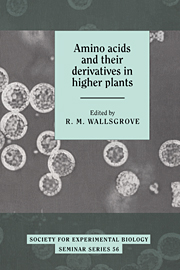Book contents
- Frontmatter
- Contents
- List of contributors
- Preface
- Glutamine synthetase in higher plants: molecular biology meets plant physiology
- Interactions of nitrogen and carbon metabolism: implications of PEP carboxylase and isocitrate dehydrogenase
- The genetics of aspartate derived amino acids in higher plants
- Oxidation of 1-aminocyclopropane-1-carboxylic acid (ACC) in the generation of ethylene by plants
- Regulation of carbon flow through the branched chain amino acid biosynthetic pathway
- Amino acid metabolism and protein deposition in the endosperm of wheat: synthesis of proline via ornithine
- The glycine decarboxylase complex in higher plant mitochondria: structure, function and biogenesis
- Glycine and serine synthesis in non-photosynthetic tissues
- Biogenesis of N-heterocydic amino acids by plants: mechanisms of biological significance
- Toxicity of non-protein amino acids from plants
- Processes involved in glutathione metabolism
- Betaines in higher plants – biosynthesis and role in stress metabolism
- Metabolism and function of polyamines during osmotically induced senescence in oat leaves and protoplasts
- Biosynthesis of cyanogenic glucosides. Elucidation of the pathway and characterization of the cytochromes P-450 involved
- The biosynthesis of glucosinolates in Brassicas
- Biochemical genetics of aliphatic glucosinolates in Brassica and Arabidopsis
- Index
Toxicity of non-protein amino acids from plants
Published online by Cambridge University Press: 09 April 2010
- Frontmatter
- Contents
- List of contributors
- Preface
- Glutamine synthetase in higher plants: molecular biology meets plant physiology
- Interactions of nitrogen and carbon metabolism: implications of PEP carboxylase and isocitrate dehydrogenase
- The genetics of aspartate derived amino acids in higher plants
- Oxidation of 1-aminocyclopropane-1-carboxylic acid (ACC) in the generation of ethylene by plants
- Regulation of carbon flow through the branched chain amino acid biosynthetic pathway
- Amino acid metabolism and protein deposition in the endosperm of wheat: synthesis of proline via ornithine
- The glycine decarboxylase complex in higher plant mitochondria: structure, function and biogenesis
- Glycine and serine synthesis in non-photosynthetic tissues
- Biogenesis of N-heterocydic amino acids by plants: mechanisms of biological significance
- Toxicity of non-protein amino acids from plants
- Processes involved in glutathione metabolism
- Betaines in higher plants – biosynthesis and role in stress metabolism
- Metabolism and function of polyamines during osmotically induced senescence in oat leaves and protoplasts
- Biosynthesis of cyanogenic glucosides. Elucidation of the pathway and characterization of the cytochromes P-450 involved
- The biosynthesis of glucosinolates in Brassicas
- Biochemical genetics of aliphatic glucosinolates in Brassica and Arabidopsis
- Index
Summary
Introduction
Over 200 non-protein amino acids occur naturally in plants (Rosenthal, 1982). With a few exceptions, these amino acids exist in unconjugated forms and many are associated with toxic properties (D'Mello, 1991). Legumes contain higher concentrations and a more diverse range of non-protein amino acids than any other plant species, and the seed is generally the most concentrated source of these substances.
The toxic non-protein amino acids are a distinguishing feature of many tropical legumes (D'Mello, 1992), contributing significantly to the noxious effects of a number of grain and forage legumes, including Canavalia ensiformis, Indigofera spicata, Leucaena leucocephala and at least three Lathyrus species. However, there is evidence of considerable variation in the concentrations of non-protein amino acids in different species of the same genus (Aylward et al, 1987). Toxic non-protein amino acids also occur in non-leguminous plants, both tropical (e.g. Blighia sapida; Cycas circinalis) and temperate (e.g. Brassica species).
The toxicity of non-protein amino acids has been observed in insects, laboratory and farm animals and in humans, but there are striking differences among animal species in their sensitivity to these compounds. Factors such as diet, duration of feeding and geographical differences in microbial ecology in ruminants may also modulate the response to these amino acids.
The role of the non-protein amino acids in plants remains a matter of some debate. However, there is mounting evidence that these compounds form part of the chemical defence system against predation and disease (Rosenthal & Bell, 1979).
- Type
- Chapter
- Information
- Amino Acids and their Derivatives in Higher Plants , pp. 145 - 154Publisher: Cambridge University PressPrint publication year: 1995
- 3
- Cited by



